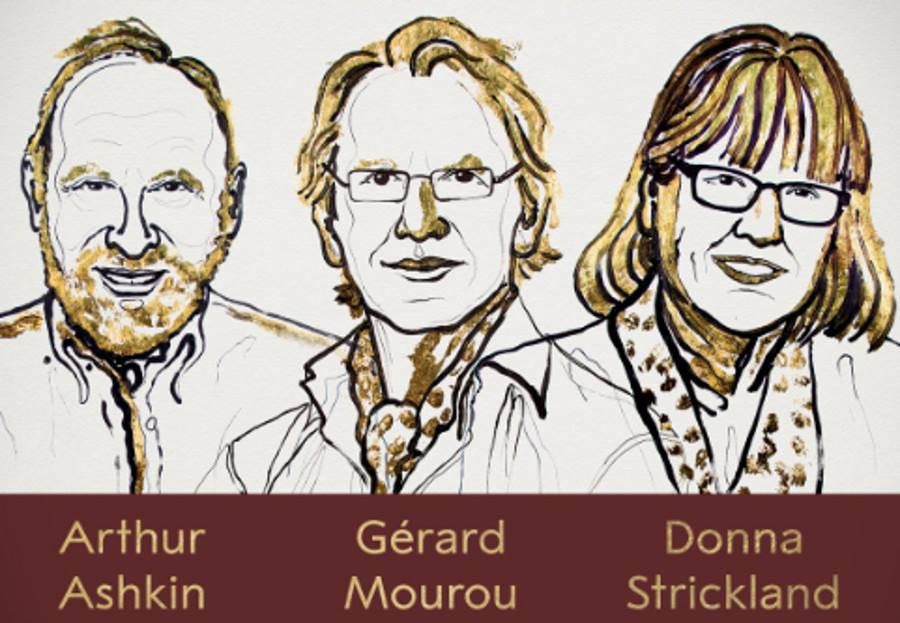The winners of the 2018 Nobel Prize in Physics have been announced
KroThe left Swedish Academy of Sciences has decided to award the Nobel Prize in Physics to Arthur Ashkin, Gérard Mourou and Donna Strickland. This year marks the first time in 55 years that a woman has been honored.
This year’s award was divided into two parts. Half will be awarded to Arthur Ashkin „for optical tweezers and their application in biological systems". The second part will go to Gérard Mourou and Donna Strickland "for a method of generating ultracrosuch impulsesoin high-intensity optical”.
This year’s inventions have revolutionized laser physics. They allow us to observe extremely small objects and incredibly fast processes in new light. Advanced precision instruments open up new areas of research and many industrial and medical applications.
Ashkin will create something like a light trap, called optical pincers. These tweezers grab atoms and molecules using a laser beam. They can study and manipulate viruses, bacteria and other living cellsorkami without damaging them. They offer entirely new opportunities to observe and control the machinery of life.
The pincers, created by Ashkin, are a tool with which theormu can observe, rotate, trim, push or pull micro-objects using light. In many laboratories, these types of laser pliers are used to study processesoIn biologicals, the engineoIn molecular, DNA or the inner life of comorek.
In turn, Mourou, along with Strickland, developed a technique with which toorej can track electrons moving in atoms. The method involves generating extremely krottleow, whichore are generated by lasers. Im kroThe tighter the pulses, the faster the processes can be observed.
Mourou and Strickland have paved the way for the mostoThe tensest and most intense pulsesoin lasers created by mankind. Developed by this dwojka researchers technique has opened up new areas of research.
Mourou and Strickland’s technique is known as pulse amplificationoIn chirped or CPA (chirped pulse amplification). The technique involves stretching the impulseoin lasers over time to reduce their power. Then such pulses are amplified and compressed. Yes the beam contains more light in the same space, and this means rapidly increasing the intensity of the pulse. Below is a diagram of how the CPA works.

Photo. Johan Jarnestad/Royal Swedish Academy of Sciences
Strickland is only the third woman to be honored with the Nobel Prize in Physics. In front of her, theoThis designation was given to Maria Skłodowska-Curie in 1903 and Maria Goeppert-Mayer in 1963.
Watch the moment the 2018 #NobelPrize in Physics is announced.
Presented by Göran K. Hansson, Secretary General of the Royal Swedish Academy of Sciences. pic.twitter.com/EukMJmGrGo
— The Nobel Prize (@NobelPrize) October 2, 2018
The Nobel Prize in Physiology or Medicine was awarded yesterday for the. It was obtained by James P. Allison and Tasuku Honjo for „discovery of anti-cancer therapy by inhibiting negative immune regulation". The results of their research have contributed to the development of therapies used to treat canceroIn immunogenic, that is, those thatore they inhibit the immune system. Read more in text: 2018 Nobel Prize in Medicine and Physiology awarded.
To date, 111 Prizes have been awardedod Nobel Prize in physics. WyroThis exemption has been granted since 1901. A total of 206 scientists have received themow. Amongod there were only two women, and one of them was Maria Curie-Skłodowska, whoora oprocz Nobel Prize in physics also received the Nobel Prize in chemistry. He is the only two-time winner of the Nobel Prize in physics, John Bardeen. The first wyroThe award was given in 19956 for research on połrzewodniki and the development of the transistor. He was awarded for the second time in 1972. for "formulation of the theory of superconductivity".
To date, the youngest Nobel Prize winner in physics is Lawrence Bragg, whoory was 25 years old when, in 1915, he and his father received the Nobel Prize. Gentlemen wyroThey were awarded for their contribution to the study of crystal structure using X-rays.
In contrast, the oldest Nobel Prize winner in physics is Raymond Davis Jr., ktory was 88 years old when he received the Nobel Prize in 2002. His work on neutrino detection was rewarded.
Last year’s Nobel Prize winners in physics were Rainer Weiss, Barry C. Barish and Kip S. Thorne for its contribution to the discovery of gravitational waves. Read more in the text: 2017 Nobel Prize in Physics awarded.
In the regulations of the award stands a provision that it can be awarded to a maximum of three people. The winner or winners this year will receive 9 millionoin Swedish crowns. This translates into about 870 thousand. euro. They will also receive a medal and a diploma.
